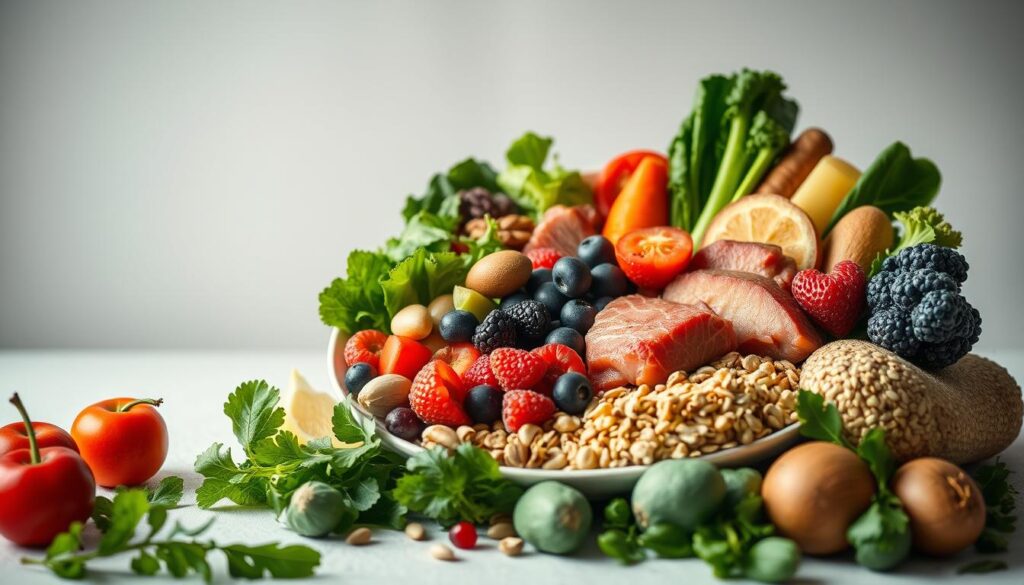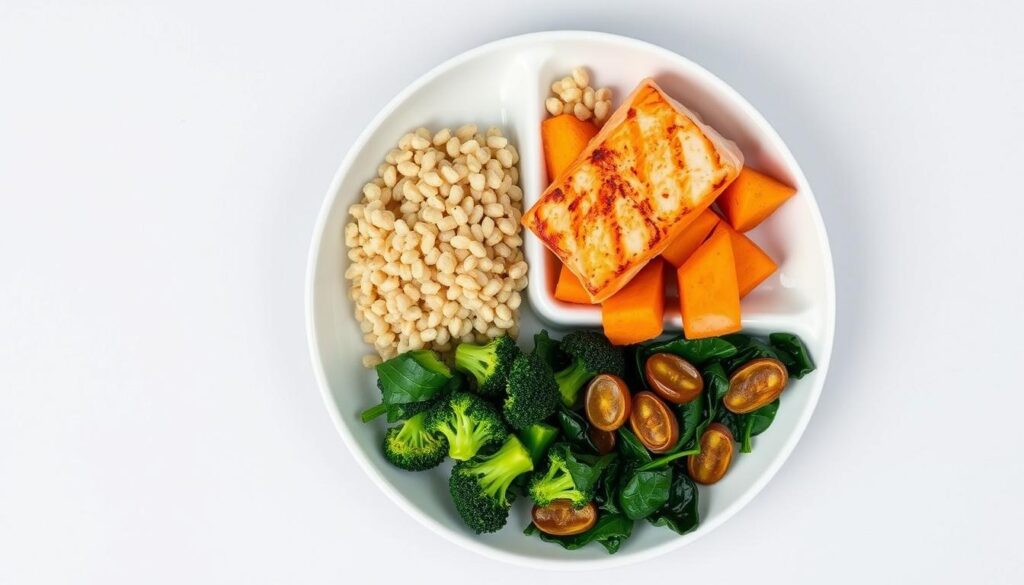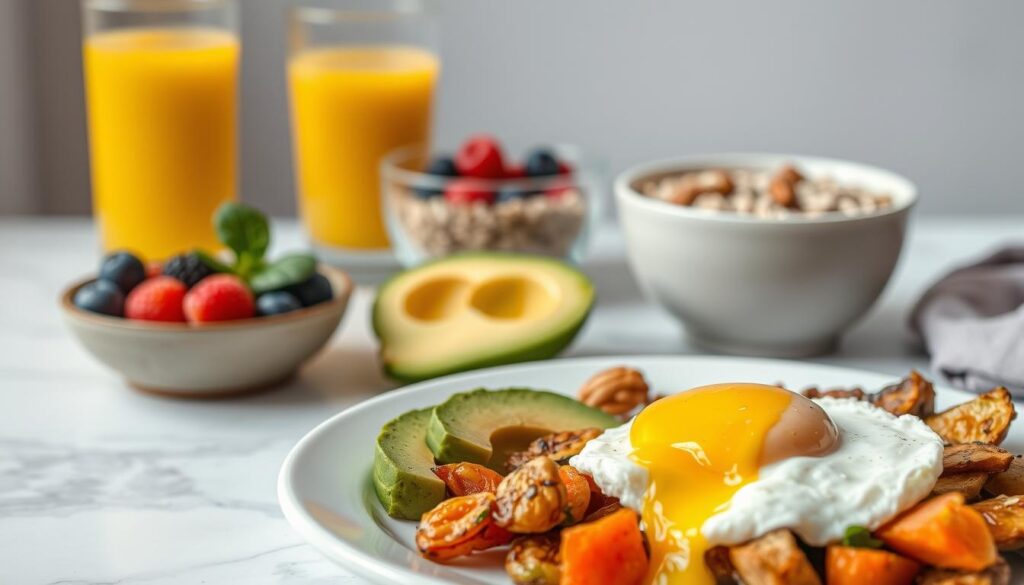How to Build a Menopause-Friendly Plate: Macronutrient Guidelines
You wake up at 3 AM drenched in sweat, your heart racing. The sheets stick to your skin as you wonder if this is your new normal.
If you’re navigating menopause, you’re not alone in feeling like your body has become a stranger. The good news is that what you put on your plate can transform how you feel during this transition.
Your journey through menopause doesn’t have to be a struggle.
By understanding how to build a menopause-friendly plate with the right balance of nutrients, you can regain control over your symptoms and energy levels. Think of menopause nutrition as your personal roadmap to feeling like yourself again.

The secret lies in mastering macronutrient guidelines for menopause. When estrogen levels drop, your metabolism shifts gears. Your body processes food differently now.
Weight creeps up around your middle. Energy crashes in the afternoon. Sleep becomes elusive. But with the right menopause diet plan, you can work with your changing body instead of against it.
Creating balanced meals isn’t about restriction or counting every calorie. It’s about nourishing your body with the specific ratios of protein, healthy fats, and smart carbohydrates that support you through this transition.
When you build a menopause-friendly plate correctly, you’re giving yourself the tools to manage hot flashes, protect your bones, and maintain a healthy weight.
Understanding Menopause and Nutritional Needs
Your body goes through big hormonal changes during menopause. This affects how you use and store nutrients. With less estrogen, fat tends to build up around your waist. This change is more noticeable in postmenopausal women.
Night sweats and hot flashes can mess with your blood sugar. This makes you hungrier and crave certain foods. As you age, your metabolism slows down. So, it’s key to know your menopause nutritional needs.
++ Fermented Foods and Menopause: Boosting Gut Health
Most women need at least 1,800 calories a day to keep their weight stable. But, this number can change based on how active you are.
To create a menopause-friendly diet, focus on important nutrients. These help your body adapt to the changes:
| Essential Nutrient | Daily Recommendation | Primary Benefits |
|---|---|---|
| Protein | 1.2-1.5g per kg body weight | Maintains muscle mass, supports metabolism |
| Calcium | 1,200mg | Bone health, reduces fracture risk |
| Omega-3 Fatty Acids | 1,100mg | Reduces inflammation, supports heart health |
| Magnesium | 320mg | Better sleep, mood regulation |
| Fiber | 25g | Digestive health, blood sugar control |
Managing work and home life can make it hard to find time for exercise. Knowing these changes helps you make better food choices. This supports your health during this time.
The Role of Macronutrients in Menopause Management
Menopause brings big changes to how your body uses nutrients. Knowing about macronutrients for menopause is key to keeping your energy up and handling physical changes.
The right mix of proteins, fats, and carbs can greatly improve your daily mood.
To manage weight during menopause, finding the right macronutrient mix is vital. Women who work out a lot do well with 35% protein, 25% healthy fats, and 40% carbs.
This mix keeps your energy steady, helps keep muscles strong, and supports hormone health.
Protein is especially important as you get older. Your body needs more protein after 50 to keep muscles strong. Studies show women who eat 1-2 grams of protein for every kilogram of body weight do better during menopause.
Protein makes you feel full longer because it takes longer to digest.
Also read: The Best Phytoestrogen Foods for Hormonal Balance
When you build a menopause-friendly plate with macros, remember carbs are your main energy source. Choose complex carbs from whole grains and veggies to avoid blood sugar spikes.
Healthy fats from olive oil, avocados, and nuts help with hormone production and vitamin absorption, which is good for bones during this time.
Optimal Protein Guidelines for Menopausal Women
Menopause brings big changes to your body, affecting muscle and bone strength. With lower estrogen, focusing on protein is key to stay healthy and full of energy.
Experts say you should eat 1-2 grams of protein for every kilogram of your weight each day. This helps fight muscle loss that happens naturally during menopause.
Read more: Top 7 Calcium-Rich Foods to Protect Bone Health in Menopause
A 2017 study showed that eating 5 grams of collagen peptides daily improved bone density in postmenopausal women.
It’s important to eat a variety of proteins. A study found that dairy protein lowered hip fracture risk by 8%. Plant protein was even better, reducing risk by 12%. To make a protein-rich plate, include:
| Animal Proteins | Plant Proteins |
|---|---|
| Chicken breast | Tofu |
| Lean beef | Lentils |
| Fish (salmon, tuna) | Black beans |
| Eggs | Almonds |
| Greek yogurt | Quinoa |
Eat protein at every meal and snack to keep your energy up. Use protein powder in smoothies or baked goods when fresh foods aren’t easy.
This plan helps with weight, keeps muscles strong, and supports bone health during menopause.
How to Build a Menopause-Friendly Plate
Creating a balanced plate for menopause starts with understanding portion sizes and food combinations.
Your meal planning should focus on filling your plate with specific food groups. These groups help manage symptoms and support your changing body.

When building a menopause-friendly plate, aim for meals with enough protein and fiber. Aim for 80 grams of protein and 30 grams of fiber daily. This helps maintain muscle mass and supports digestive health.
Start by dividing your plate into sections. Half should be non-starchy vegetables, one quarter for lean protein, and one quarter for whole grains.
| Food Category | Portion Size | Examples |
|---|---|---|
| Lean Protein | ¼ of plate | Grilled salmon, chicken breast, tofu, lentils |
| Non-Starchy Vegetables | ½ of plate | Broccoli, spinach, bell peppers, Brussels sprouts |
| Whole Grains | ¼ of plate | Quinoa, brown rice, oats, whole wheat pasta |
| Healthy Fats | 1-2 tablespoons | Avocado, olive oil, almonds, walnuts |
Your balanced plate for menopause should include nutrient-dense foods at every meal. Choose wild-caught fish, grass-fed beef, or plant-based proteins like chickpeas. Add colorful vegetables and leafy greens for vitamins and minerals.
Include healthy fats from sources like avocados and nuts. These fats support hormone production and improve sleep quality.
When hungry between meals, drink water, eat fresh fruit, or raw vegetables instead of processed snacks.
Incorporating Healthy Fats for Hormone Support
Healthy fats are key to balancing hormones during menopause. Studies from 2020 show that women with more omega-3s have better health. Those with diabetes or heart disease after menopause have lower omega-3 levels.
Fatty fish like salmon, mackerel, and anchovies are great for omega-3s. Chia seeds, flaxseeds, and hemp seeds are good plant-based options. Eating these foods regularly can help manage menopause symptoms.
Make sure to eat monounsaturated and polyunsaturated fats every day. Olive oil, avocados, almonds, and walnuts are full of these healthy fats. They help regulate hormones better than saturated or trans fats.
| Food Source | Type of Fat | Serving Size |
|---|---|---|
| Wild Salmon | Omega-3 Fatty Acids | 3-4 ounces |
| Avocado | Monounsaturated | 1/2 medium |
| Chia Seeds | Omega-3 Fatty Acids | 2 tablespoons |
| Extra Virgin Olive Oil | Monounsaturated | 1 tablespoon |
Eating these foods regularly helps keep hormone levels steady during menopause. Try to add a healthy fat source to each meal for the best results.
Smart Carbohydrate Choices for Blood Sugar Balance
Managing carbs during menopause is key as your metabolism shifts. Your body now handles sugars differently. This makes choosing carbs wisely important for steady energy all day.
Avoid processed foods and refined sugars, as they can cause hot flashes and mood swings. An occasional soda or sweet treat is okay.
But, choose a banana or apple when you crave something sweet. These whole foods offer natural sweetness and fiber, which slow down sugar absorption.
When building a menopause-friendly plate, focus on nutrient-dense carbs. Whole grains are packed with B vitamins like thiamine, niacin, and riboflavin.
These vitamins help with energy and nervous system health. A 2021 study found that eating more whole grains and veggies can lessen menopause symptoms.
| Smart Carb Choice | Key Nutrients | Menopause Benefits |
|---|---|---|
| Brown Rice | Fiber, Magnesium | Stabilizes blood sugar, supports sleep |
| Quinoa | Protein, Iron | Boosts energy, reduces fatigue |
| Oats | Beta-glucan, B vitamins | Lowers cholesterol, steadies mood |
| Barley | Selenium, Fiber | Supports thyroid, aids digestion |
When shopping, always check labels. Look for “whole grain” as the first ingredient. Your heart, bones, and hormones will benefit from these simple changes.
Phytoestrogen-Rich Foods and Their Benefits
Phytoestrogens for menopause offer a natural way to manage symptoms. These plant compounds act like estrogen in your body.
They provide gentle hormonal support during this time. Studies show they may also improve bone density and lower heart risks in postmenopausal women.
When building a menopause-friendly plate, phytoestrogens are crucial.
The best foods include soybeans, chickpeas, peanuts, flaxseed, barley, grapes, berries, plums, green tea, and black tea. Each food offers unique benefits for your changing body.
A 2020 study found that women who ate more fruits and veggies had fewer symptoms. Dark berries are especially beneficial.
A study with 60 postmenopausal women showed that eating 25 grams of freeze-dried strawberry powder daily lowered blood pressure.
Eat a variety of colorful produce to maximize benefits. Red strawberries, purple grapes, orange carrots, and green broccoli each offer different phytoestrogens and nutrients. This variety ensures you get all the vitamins and minerals your body needs during menopause.
Start by adding one phytoestrogen-rich food to each meal. Sprinkle ground flaxseed on oatmeal, snack on edamame, or enjoy berries for dessert. These small changes can make a big difference in how you feel.
Sample Meal Plans and Practical Applications
Creating effective menopause meal plans means balancing protein, fiber, and omega-3 fatty acids all day. These examples show how to make a menopause-friendly plate that meets your changing needs.
Begin with nutrient-rich breakfasts like a Berry Protein Smoothie with Greek yogurt, mixed berries, and protein powder for 25 grams of protein. Or, try scrambled eggs with spinach and whole grain toast for lasting energy.

For lunch, choose lean proteins and healthy fats. A Salmon and Avocado Salad has 30 grams of protein and omega-3s. For plant-based, try a Quinoa and Black Bean Bowl with pumpkin seeds and tahini dressing.
| Meal | Calories | Protein (g) | Fiber (g) |
|---|---|---|---|
| Breakfast: Berry Smoothie | 250 | 25 | 8 |
| Lunch: Salmon Salad | 420 | 30 | 12 |
| Dinner: Tofu Stir-Fry | 300 | 20 | 10 |
| Snacks: Greek Yogurt | 200 | 15 | 4 |
| Daily Total | 1,170 | 90 | 34 |
Evening meals can include Tofu and Vegetable Stir-Fry or lean beef with steamed broccoli.
These recipes offer key nutrients while keeping calories in check. Keep track of your macronutrients daily and adjust portions based on your activity level and goals.
Conclusion
Creating a menopause-friendly plate is all about balance. It’s about choosing the right foods for every meal. Your plate should have colorful veggies, lean proteins like salmon, and whole grains like quinoa.
It’s also important to limit foods that can make symptoms worse. Avoid processed snacks, sugary drinks, and high-sodium foods.
Cut down on alcohol and caffeine to help with sleep and hot flashes. Instead, eat foods rich in phytoestrogens and omega-3s.
Changing your diet for menopause takes time and effort. You might start to feel better in two to four weeks. Keep up with your new diet, exercise regularly, and get enough sleep.
Work with your doctor to make sure you’re on the right track. These changes can make your menopause journey easier and keep you healthy for years.
